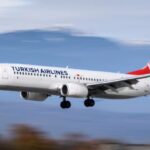Thursday was a big day for Aer Lingus, Ireland’s national carrier. Since 1995, Aer Lingus has been known for its all-green planes. Now, it is time for a change, or so Aer Lingus thinks. The airline unveiled a new livery at noon on Thursday. The first aircraft wearing the new livery are an Airbus A330-300 (registration EI-EDY) and an A320-200 (registration EI-CVA).

EI-CVA, the first A320 repainted in the new livery pictured at Dublin Airport.
Sean Doyle, Aer Lingus’ CEO, was delighted to present the brand refresh. “[This new branding] reflects our position as a modern, innovative airline. Aer Lingus has evolved from an Irish airline that flies internationally to an international airline that is proud to be Irish,” Doyle said.
So what is new? The most notable aspect is the fuselage, which will be switched from green to white. The engines are fully painted in the new teal color, adding a splash of color on each side.
The color palette on the tail and rear fuselage consists of two contrasting shades of green. The rich teal represents strength and confidence, while the light green stripe modernizes the design and reflects Aer Lingus’ value carrier proposition. The tail includes a shamrock, the emblem of Ireland. The shamrock’s light green shade contrasts the surrounding teal; the shamrock sits proudly as the hero of the livery.

Aer Lingus crews will also benefit from the rebranding. Members will receive new uniforms in the coming months. The new branding has already been rolled out on Aer Lingus’ official website and mobile apps.
Beyond the new brand identity, Aer Lingus is proud of its growth. The airline plans to add several new routes in 2019 and introduce its first A321LRs. The North Atlantic fleet will grow from 17 to 30 aircraft, increasing the A330 fleet to 16 aircraft and adding 14 A321LRs.
The cleaner design appears to follow similar principles to those adopted by fellow IAG carrier Iberia when it launched its new livery in 2013.
Aer Lingus states it plans to complete the roll-out of the new livery across its entire fleet by 2021.
Sources: Aeronautics, FG, Airportspotting, Aer Lingus








